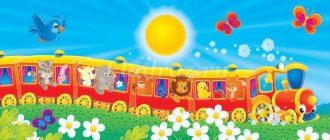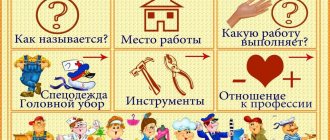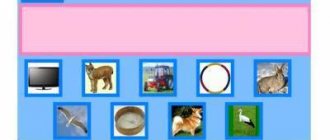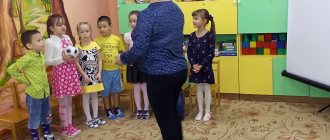How do classes with a speech therapist work in kindergarten?
How are classes conducted with a speech therapist in kindergarten?
In kindergarten, individual speech therapy classes begin with children who have reached 4.5 years of age. They are held 2 times a week for 20 minutes. The speech therapist gives home tasks that need to be completed every day in order to quickly improve the quality of speech! For this house you will need a mirror, a notebook for homework, a table, chairs for you and the child, a good mood!
Corrective speech therapy
work is carried out in several directions:
1. Articulation gymnastics (we develop articulatory muscles in a playful way)
2. Speech therapy massage (strengthening/relaxing articulatory muscles, improving their tactile sensitivity)
3. Development of phonemic perception (the ability to distinguish and isolate specified sounds from a stream of speech)
4. Development of phonemic analysis and synthesis skills (the ability to determine the position of a sound in a word, their number, stressed vowel sound, divide words into syllables and determine the number of words in a sentence using diagrams)
5. Development of a good strong, directional air stream (important for pronouncing many sounds, especially P, P', since the air helps to vibrate the tip of the tongue)
6. Development of fine motor skills of the hands (Speech zones and zones of the hands in the cerebral cortex are interconnected. In this way we improve the quality of articulatory movements)
7. Staging, automation of delivered sounds, their differentiation with other similar-sounding sounds and introduction into speech
8. Development of lexical and grammatical aspects of speech
9. Development of visual-spatial orientation, attention, memory
The speech therapist, parents and child must work together! All classes are conducted in a playful way, taking into account the leading activity of preschool children - play! When giving tasks, explaining something, showing an articulation exercise, it is important to reinforce this with a verbal or visual playful image, since the interest and interest of the baby is our task!
Speech of younger preschoolers
If a child does not pronounce a sound or several sounds correctly (distorts, skips or replaces with another), then, based on age norms and possible causes (delayed speech development, increased/decreased tone in the articulatory muscles, insufficient phonemic perception, incomplete dentition, short hyoid frenulum...) we need to help him master them in a timely manner! Sometimes a violation of sound pronunciation is combined with incorrect coherent speech and its grammatical design (the phrase is ungrammatical, there are errors in word formation and inflection, prepositions are not used or are pronounced incorrectly...), and a limited vocabulary. In this case, we are talking about a general underdevelopment of speech. Such difficulties in mastering the norms of native speech may be due to hereditary predisposition, unfavorable environment, impaired brain maturation (speech zones) under the influence of certain factors operating in the prenatal period, at the time of birth or the first years of the child’s life.
To avoid possible errors in writing and reading, you should try to correct speech impairments even before entering school. Perhaps in the future your child will choose a profession related to good speech!
Speech of children by the age of two:
1. Children understand the actions and objects indicated in simple plot pictures. 2. Fulfill the requests of adults, consisting of two parts. 3. Understand the meaning of spatial prepositions (put it on the table, sit on the sofa). 4. Understand the general meaning of the names of homogeneous objects (any chair is a chair). 5. After 1.5 years they begin to ask questions: “What is it called?”, “What is it?” 6. By the age of 1.5 years, the child’s active vocabulary contains about 50 words, and by the age of 2 – 200-400 words, mainly nouns denoting play and household items, as well as verbs denoting simple actions. 7. Speech is ungrammatical. They use a phrase of 2-4 words, agree 3rd person singular verbs of the present tense with nouns, use forms of some cases; The first person of verbs and the pronoun “I” appear. 8. There are many verbs in the imperative mood in the speech. 9. Incorrect sound pronunciation of most sounds of the native language is characteristic (stage of physiological tongue-tiedness). 10. Unstable pronunciation of many words: the sound is dropped out, then replaced, then pronounced correctly. 11. The syllabic structure of polysyllabic words is disrupted (simplification of the structure by omitting syllables from the middle of the word). 12. Some children have a weak, quiet voice.
Speech of children by the age of three: 1. The most important difference between the speech of a three-year-old child and a two-year-old is the almost complete absence of agrammatisms in the speech of a three-year-old. 2. The connection of words in a sentence is established with the help of endings and prepositions, conjunctions are used, and all main parts of speech are used. 3. The vocabulary is characterized not only by words of purely everyday topics; there are words of evaluative meaning, words of generalization. The child already operates with some generic concepts. 4. Sound pronunciation is not yet fully consistent with the norm. There are no sibilants and sonorants. Hard and soft sounds are differentiated by most children. 5. Words with a complex syllable structure and consonant clusters may be pronounced distorted. 6. If a child has formed a positive attitude towards books, he loves to listen to familiar fairy tales and poems over and over again. He remembers the text well and reproduces it verbatim. It still doesn’t give you a free retelling in your own words. 7. Understands simple plot pictures.
Speech of children by the age of four:
1. Vocabulary reaches 2000 words. 2. Words of the second degree of generalization appear in active speech. 3. The vocabulary is enriched by adverbs denoting spatial and temporal characteristics. 4. “Word creation” appears, which indicates the beginning of the assimilation of word-formation models. 5. In speech there are fewer and fewer errors in inflection of the main parts of speech. 6. In many children, sound pronunciation has returned to normal; in some children, there is a mixture of whistling and hissing sounds, as well as the absence of vibrants P, P'. 7. Coherent speech has not yet developed; inconsistency is allowed in stories about events and from one’s own life; a retelling of a famous fairy tale is possible. 8. Well-developed involuntary memory at this age allows you to remember a large number of poetic works by heart.
Speech of older preschoolers (5-7 years old)
1. A qualitative leap in mastering coherent speech: children are able to compose a story based on a picture, retell the text in the required temporal and logical sequence. 2. Inner speech begins to form - a compressed, abbreviated form of speech, with the help of which upcoming activities are planned. 3. The vocabulary has been significantly enriched; children use words of the second degree of generalization. 4. There are no gross agrammatisms in speech; errors are possible when constructing complex sentences. 5. Sound pronunciation has completely returned to normal. 6. The ability to isolate sound from a word appears, that is, the skills of sound analysis of words are formed; the sound shell of a word is no longer “transparent”, invisible to perception. 7. Children are able to change the volume of their voice at will and can reproduce different intonations.
To successfully master writing (its technique), a child must already have the following necessary prerequisites for writing at preschool age:
1. Development by ear of all speech sounds, including acoustically and articulatory sounds (voiced-voiceless, soft-hard, whistling-hissing, R-L-Y)
2. Correct pronunciation of all speech sounds (no replacement of some sounds with others)
3. Knowledge of the simplest types of analysis available to preschool children:
- highlighting a sound against the background of a word (for example: is there a sound P in the word FISH? And in the words BALL, PICTURE)
- determination of the place of a sound in a word (beginning, middle, end. For example: In the word MACHINE, the sound Ш is in the middle)
-isolating a stressed vowel sound from the beginning and end of a word (For example: What is the first sound in the word Stork?)
In the process of special training in the kindergarten program, preschoolers master more complex types of sound analysis of words.
1. A sufficient level of formation of visual-spatial concepts (the ability to distinguish objects and geometric figures by shape, size, location in space), which is necessary for the strong assimilation of visual images of letters.
To avoid possible errors in writing and reading, you should try to correct oral speech disorders before entering school. Perhaps in the future your child will choose a profession related to good speech!
Why does the child speak poorly?
Here are the most common reasons:
1.
Imitating the incorrect speech of others
- not only adults, but also children.
Make an effort to ensure that your baby hears correct speech more often than defective speech. It is also important to ensure that when communicating with your child you avoid the so-called “lisping”. Remember that audio recordings and cartoons do not replace or complement live communication; dialogue is necessary for the development of a child’s speech and the formation of coherent speech skills.
2.
Weakness of the muscles of the tongue
, lips or slight coordination disorder, i.e. the child cannot perform precise targeted movements with the tongue and lips.
In order to check whether this is the reason for the incorrect pronunciation of the sound in
, you need to offer to perform a series of exercises that you show him.
While performing, the child should see himself in the mirror. It’s better if you imagine everything as a fairy tale
which you will show together.
Exercise in the form of a Fairy Tale
:
Once upon a time there lived a Bubble (puff out our cheeks) and a Straw (pull in our cheeks).
In the morning, Bubble always smiled (lips in a wide smile, upper and lower teeth visible).
And Straw was sulking at him (his lips stretch forward like a tube) because he didn’t want to wash his face.
They went to brush their teeth together. First they brushed the upper teeth (the wide tongue behind the upper teeth).
They tried very hard and cleaned them right, left, inside, outside (corresponding movements with a wide tongue).
Then they brushed the lower teeth (repeating the movements of the tongue behind the lower teeth).
At the end, they rinsed their mouths (alternately puffing out their cheeks - lips tightly closed).
It was time for breakfast. The straw set the samovar, which puffed like this (inflating both cheeks at the same time, followed by releasing air through the lips).
And I fried pancakes, like these (a wide tongue lies on the lower lip).
Lapot ate pancakes with pleasure (we slapped the spread tongue with our lips, the sound was “five-five-five”).
Licking the jam from the lip like this (we lick the upper lip from front to back with a wide tongue).
The breakfast was so delicious that Lapot was licking his lips (the tip of his tongue licks his lips in a circle).
After breakfast, Straw sat down to sew, and Lapot helped her. He took a needle (the narrow tongue is extended forward) and tried to get a thread into the ear (the narrow tongue moves back and forth), but nothing worked (the narrow tongue moves left to right).
Finally, Lapot threaded the needle, and Straw sewed on the buttons, first one, then the second (the tip of the tongue rests on one or the other cheek).
Friends went outside to swing on a swing (a wide tongue is placed alternately behind the upper and lower teeth).
And ride a horse (slow clicking while stretching the hyoid ligament).
If your fears about muscle weakness are confirmed
, then help your child strengthen them: let’s nibble on crackers, pieces of meat, and do speech exercises. Don't forget about fine motor skills, they are closely related to articulation.
3.
Poorly developed phonemic hearing
.
The child simply does not hear his incorrect pronunciation, he thinks that he is speaking correctly. You can check this by asking the child to listen to a series of sounds and “catch” (clap his hands) the given one. Example: s w zh v r sh z s... Or we ask you to repeat a series of syllables: ba-pa-ba, to-do-do!
4.
Problems due to the structural features of the articulatory apparatus
.
A short hyoid frenulum is common. Normally, it should be no shorter than 1.5 cm; the child is able to reach the upper teeth with the tip of his tongue (the mouth is slightly open). It is either stretched or trimmed. A high palate and incomplete dentition can also cause incorrect pronunciation of sounds.
Developing our fingers.
Development of manual motor skills
The need to develop hand motor skills is due to the close interaction between manual and speech motor skills. The morphological and functional formation of speech zones occurs under the influence of kinesthetic impulses coming from the hands. Improving manual motor skills contributes to the activation of motor speech areas of the brain and, as a result, the development of speech function.
At the preparatory stage of correcting sound pronunciation disorders, various types of exercises are recommended aimed at developing dexterity, accuracy, coordination, and synchronization of finger movements. There are also general exercises included in various activities:
1. Construction of houses, towers, etc. from cubes, first according to a model, then from memory and at random.
2. Unfolding and folding of collapsible toys (matryoshka dolls, pyramids, cups, cubes).
3. Drawing up subject cut-out pictures. First, the pictures are given, cut into 2 parts, then into 3 and 4. Initially they are folded according to the pattern, then later - from memory.
4. Folding geometric shapes, images, letters from sticks, beads.
5. Tracing the contours of object images.
6. Coloring outline images of objects with colored pencils.
7. Cutting out colored stripes and figures along the contours.
8. Winding thread onto a spool or ball.
9. Fastening and unfastening buttons, lacing.
10. Working with plasticine (rolling balls, flagella, flattening balls, flagella into cakes, independent creativity of children).
11. Working with mosaics.
12. Playing with cereals, cereals and legumes - pour everything into a plate and ask the child to make a sun out of peas or a letter out of beans, etc.!
13. Repeatedly clenching and unclenching your fingers.
14. Repeated alternate execution of hand movements: fist - palm - rib.
15. Alternate change of hand positions: left hand – fist, right – palm; then vice versa: the right hand is a fist, the left is a palm.
16. Finger games are played with children.
Exercises aimed at developing fine motor skills of the hands in order to improve the quality of speech:
-Goat (fingers of the trained hand are clenched into a fist, the index finger and little finger are straightened)
-Hare (fingers are clenched into a fist, the index and middle fingers are gradually straightened and spread to the sides: the bunny has stretched out its ears)
-Goat-Hare (alternating hand movements)
-Three heroes (the thumb holds the little finger, and the index, middle and ring fingers are straight)
— Fingers said hello (the tip of the thumb consistently touches the rest)
- Goose
(the hand rests on the elbow, the fingers are clenched into a fist. The thumb and index fingers are straightened and connected in the form of a beak)
-Ring (the hand rests on the elbow, the fingers are clenched into a fist, first the thumb and index fingers are straightened, connected into a ring, the remaining fingers are straightened and spread apart)
-Bird (both hands are crossed so that the thumbs catch on each other, move your hands up and down, imitating the flapping of bird wings: quickly and slowly)
-Soldiers (show fingers from fist one at a time)
-Fork (the thumb is bent into the palm, and the index, middle, ring and little fingers are straight)
-Glasses (we connect the thumb and index fingers of both hands and bring them closer to the eyes, simulating glasses)
-Fist-edge-palm (quick alternating movements of both hands on the table - in a fist on the table - the palm is edge-on - the palm is down - lying on the table)
-Salt the soup (the fingers of both hands reproduce the corresponding movements)
-Grab a pencil with the thumb and index fingers, as well as the thumb and fingers in turn
-Rolling a ball/walnut across the palm and between the fingers;
-Walking of a man (the index and middle fingers “run” across the table, first the exercise is performed with one hand, then with the other hand, then with both hands together)
-Playing the piano (children touch the table with their fingertips in sequence: with one finger: 1, 2, 3, 4, 5; 5, 4, 3, 2, 1, with two fingers: 1-5, 1-4, 1-3, 1-2; 1-2, 1-3, 1-4, 1-5)
In order to develop manual motor skills, exercises accompanied by poems and well-known folk “finger” games are also used.
“Fingers” Children raise their left hand with their palm facing them. The right hand bends the fingers. This finger wants to sleep. (Bend the little finger.) This finger went to bed. (They bend the ring finger.) This finger took a little nap. (Bend the middle finger.) This finger has already fallen asleep. (Bend the index finger.) This one is fast asleep. (They bend their thumb.) Fingers stand up, hurray. (Fingers straighten.) It’s time for us to go to school. (The index and middle fingers of the left hand “run” along the table.) Then the game is repeated with movements of the fingers of the right hand.
“This finger...” Children bend the fingers of their left hand into a fist. This finger is grandpa. (Bend the thumb.) This finger is grandma. (Bend the index finger.) This finger is daddy. (Bend the middle finger.) This finger is mommy. (Bend the ring finger.) This finger is me. (Bend the little finger.) That’s my whole family. (Extend the fingers.) Next, the game is repeated with movements of the fingers of the right hand.
The choice of exercise, didactic and speech material can be determined by the topic of the lesson. So, for example, contour images are selected (for coloring, tracing, cutting, sculpting) of those objects whose names contain the sound being practiced.
Exercises to develop manual motor skills must be carried out systematically for 3-5 minutes.
Get text





